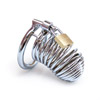Contrary to popular belief, CBT is not a BDSM practice centered around pain. Instead, it is an intimate act that involves consent, attention and care for one another. It's an opportunity for two trusting partners to indulge in the art of edging, transcending ordinary pleasure into a realm of mind-bending ecstasy.
CBT, also known as "penis play," is an intimate exploration of the male genitalia. It revolves around gentle stimulation, applying varying degrees of pressure, and incorporating sensory elements to heighten arousal. The key principle underlying CBT is trust—trust between partners to communicate their boundaries and desires, ensuring a safe and pleasurable experience.
Like any sexual activity, CBT requires explicit consent and open communication between partners. It is vital to establish clear boundaries, establish safe words, and continually check in on each other to ensure comfort and enjoyment. Consent is the cornerstone of any healthy sexual relationship, and it remains paramount when engaging in penis play. My boy Karl does a great job elaborating on SSC principles in penis play.
CBT, at its core, expresses trust and vulnerability between partners. It goes beyond physical pleasure and delves into the emotional connection between two individuals. Trust allows one partner to surrender control while the other is responsible for providing pleasure and stimulation. The power dynamics involved are not about dominance and submission but rather the relinquishing of control and the freedom to explore pleasure without fear or judgment. I mean, you understand the just - the cock and the balls in question are often one of the most precious body parts for the receiver, hence the amount of trust he puts into another player is hard to underestimate.
Now, let's talk about the sexy parts. Central to the penis play experience is the concept of edging - the practice of bringing oneself or one's partner to the brink of orgasm and then slowing down or stopping altogether. This delicate dance between euphoria and restraint enhances the sensations and intensifies the pleasure. Edging in CBT allows partners to experience heightened sensitivity, extending the pleasure and delaying gratification until an explosive orgasm is reached.
I want to make sure I say it enough - it is not about pain! It is crucial to emphasize that CBT, when practiced in a consensual and respectful manner, does not involve pain. While some individuals may find pleasure in incorporating elements of pain or discomfort into their sexual experiences, it is not inherent to CBT. Instead, CBT focuses on pleasure, sensory exploration, and the deep connection shared between partners. Yes, the withholding of an orgasm might feel intense, and so can caging, but no painful sensations. You can look at cages and other penis play toys here.
Unfortunately, CBT often suffers from a bad image due to its name and association with hardcore BDSM practices. It is vital to differentiate CBT from BDSM and highlight its distinct nature as an intimate act centered around trust, consent, and pleasure. By shedding light on the true essence of CBT, we can dispel misunderstandings and foster a more inclusive and accepting sexual culture. Of course, penis play can be BDSM-ish, involving pain and submission, but not always, and it doesn't have to be. Some toys, like leather rings, are on the farthest side of the pain spectrum. Some, like cock cages and metal rings, can edge on painful, and only I'd say urethral sounds or beaters of some kind will be considered heavy-duty pain deliverers in the realm of penis play. Be mindful and careful when using those.
CBT, or penis play, is an intimate practice that transcends stereotypes and challenges misconceptions. Grounded in trust, consent, and communication, CBT allows partners to explore pleasure, elevate their sexual experiences, and deepen their emotional connection. It is a delicate dance between blissful abandon and mindful awareness - a journey where two individuals can relinquish control, embrace vulnerability, and find profound pleasure in one another. By understanding and appreciating the essence of CBT, we open ourselves up to a realm of pleasure and connection that can truly be transformative for any relationship.
CBT, also known as "penis play," is an intimate exploration of the male genitalia. It revolves around gentle stimulation, applying varying degrees of pressure, and incorporating sensory elements to heighten arousal. The key principle underlying CBT is trust—trust between partners to communicate their boundaries and desires, ensuring a safe and pleasurable experience.
Like any sexual activity, CBT requires explicit consent and open communication between partners. It is vital to establish clear boundaries, establish safe words, and continually check in on each other to ensure comfort and enjoyment. Consent is the cornerstone of any healthy sexual relationship, and it remains paramount when engaging in penis play. My boy Karl does a great job elaborating on SSC principles in penis play.
CBT, at its core, expresses trust and vulnerability between partners. It goes beyond physical pleasure and delves into the emotional connection between two individuals. Trust allows one partner to surrender control while the other is responsible for providing pleasure and stimulation. The power dynamics involved are not about dominance and submission but rather the relinquishing of control and the freedom to explore pleasure without fear or judgment. I mean, you understand the just - the cock and the balls in question are often one of the most precious body parts for the receiver, hence the amount of trust he puts into another player is hard to underestimate.
Now, let's talk about the sexy parts. Central to the penis play experience is the concept of edging - the practice of bringing oneself or one's partner to the brink of orgasm and then slowing down or stopping altogether. This delicate dance between euphoria and restraint enhances the sensations and intensifies the pleasure. Edging in CBT allows partners to experience heightened sensitivity, extending the pleasure and delaying gratification until an explosive orgasm is reached.
I want to make sure I say it enough - it is not about pain! It is crucial to emphasize that CBT, when practiced in a consensual and respectful manner, does not involve pain. While some individuals may find pleasure in incorporating elements of pain or discomfort into their sexual experiences, it is not inherent to CBT. Instead, CBT focuses on pleasure, sensory exploration, and the deep connection shared between partners. Yes, the withholding of an orgasm might feel intense, and so can caging, but no painful sensations. You can look at cages and other penis play toys here.
Unfortunately, CBT often suffers from a bad image due to its name and association with hardcore BDSM practices. It is vital to differentiate CBT from BDSM and highlight its distinct nature as an intimate act centered around trust, consent, and pleasure. By shedding light on the true essence of CBT, we can dispel misunderstandings and foster a more inclusive and accepting sexual culture. Of course, penis play can be BDSM-ish, involving pain and submission, but not always, and it doesn't have to be. Some toys, like leather rings, are on the farthest side of the pain spectrum. Some, like cock cages and metal rings, can edge on painful, and only I'd say urethral sounds or beaters of some kind will be considered heavy-duty pain deliverers in the realm of penis play. Be mindful and careful when using those.
CBT, or penis play, is an intimate practice that transcends stereotypes and challenges misconceptions. Grounded in trust, consent, and communication, CBT allows partners to explore pleasure, elevate their sexual experiences, and deepen their emotional connection. It is a delicate dance between blissful abandon and mindful awareness - a journey where two individuals can relinquish control, embrace vulnerability, and find profound pleasure in one another. By understanding and appreciating the essence of CBT, we open ourselves up to a realm of pleasure and connection that can truly be transformative for any relationship.








Comments